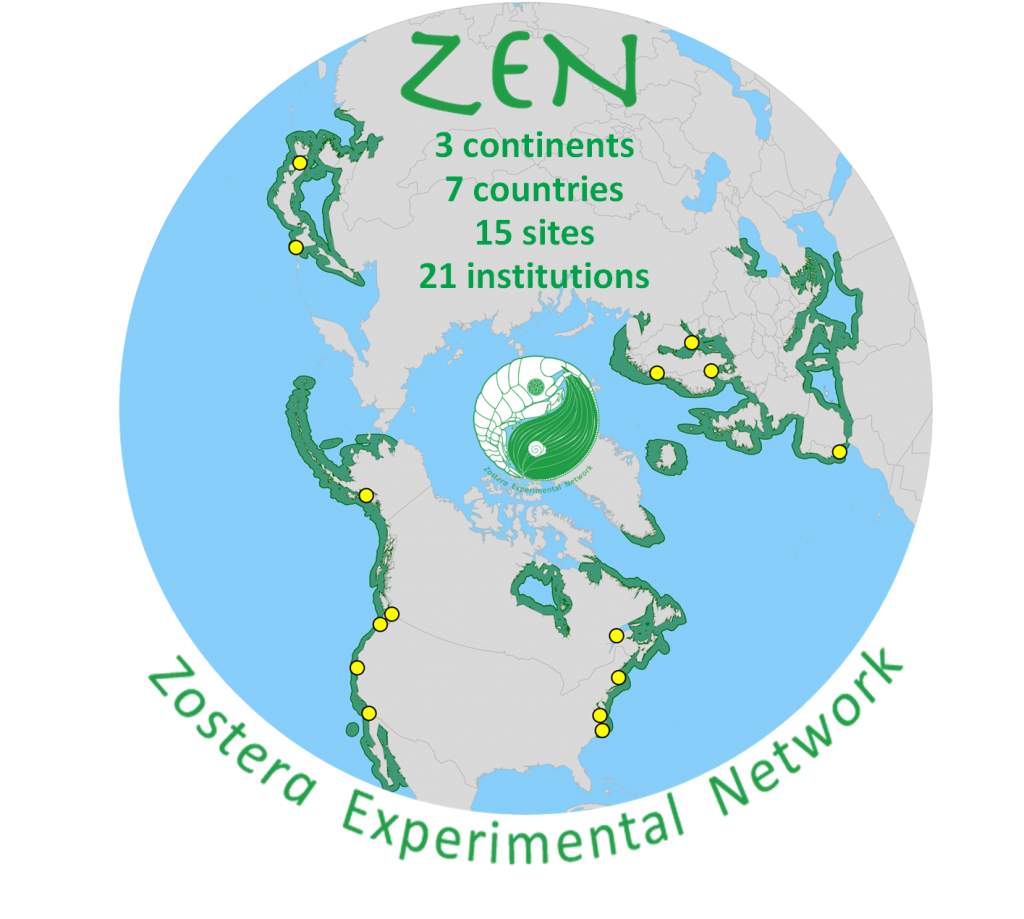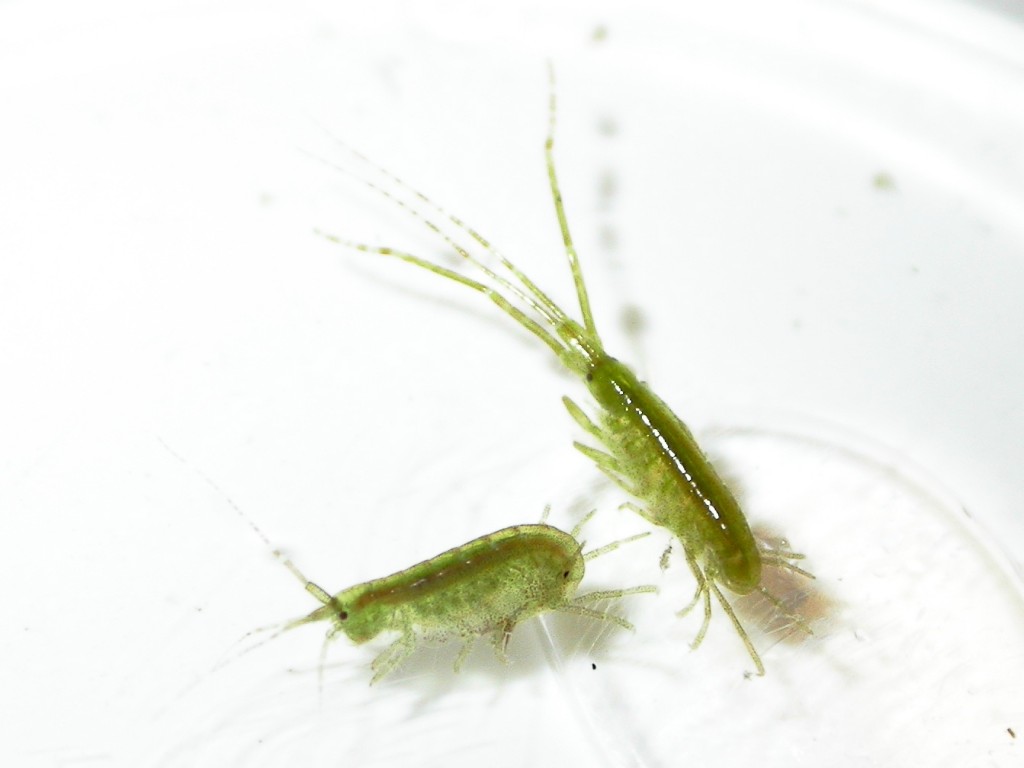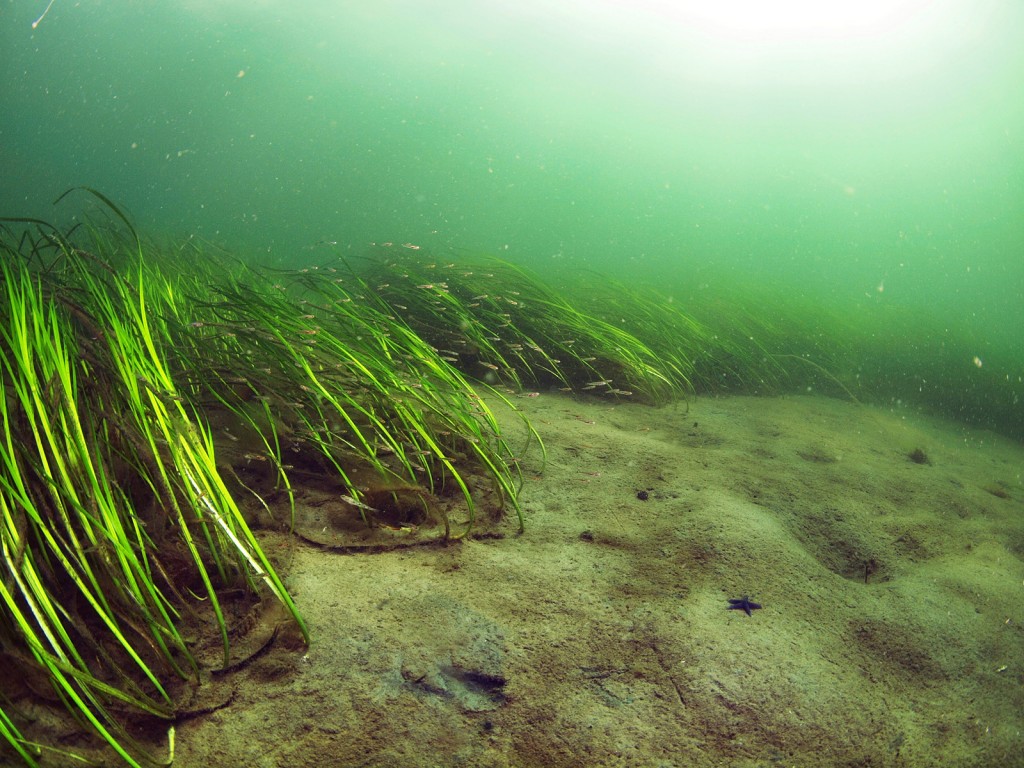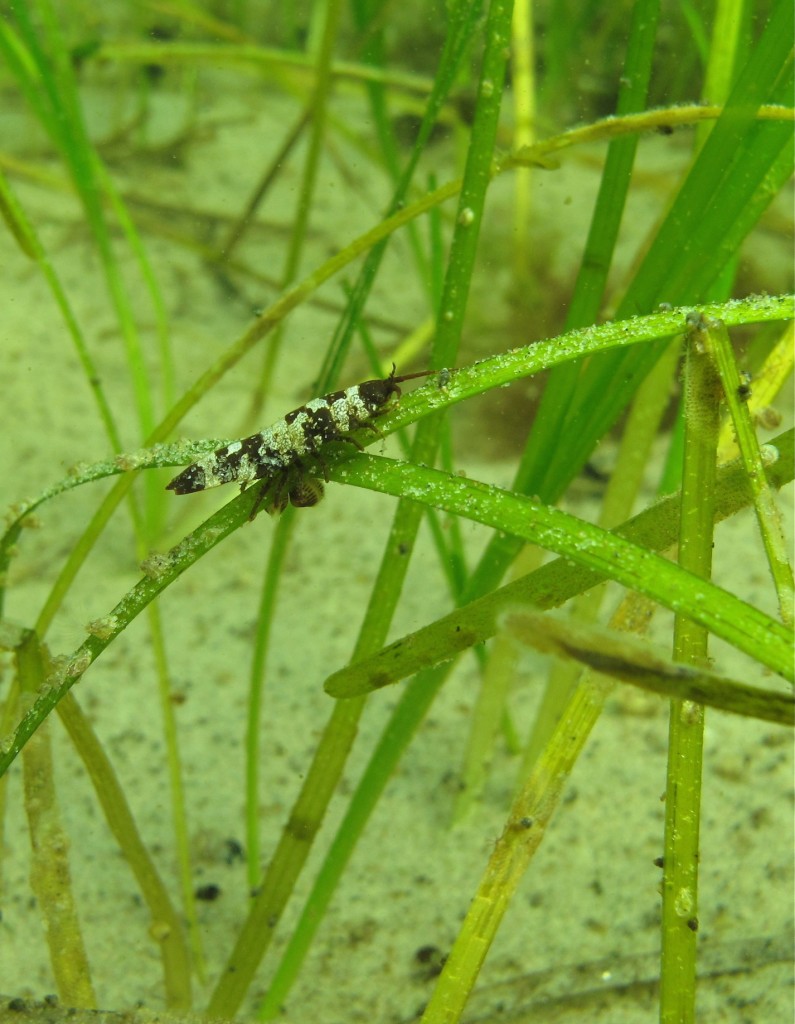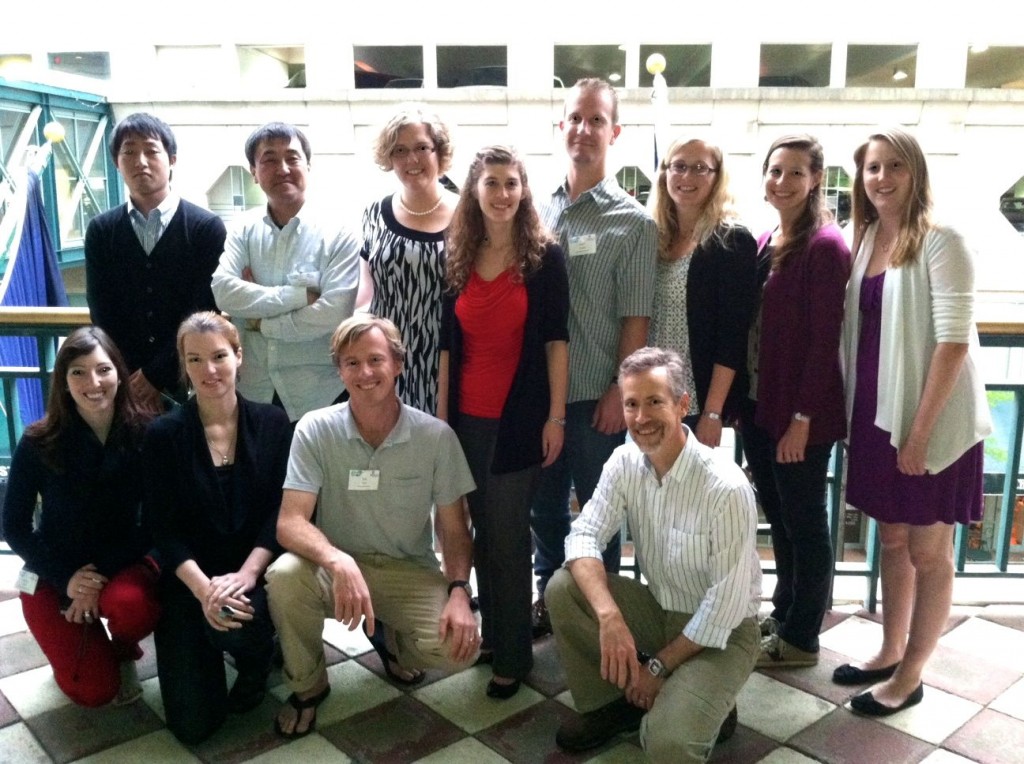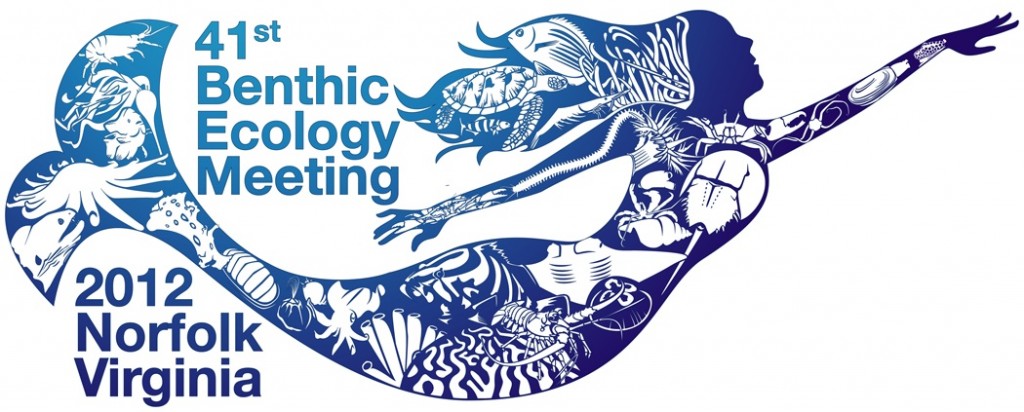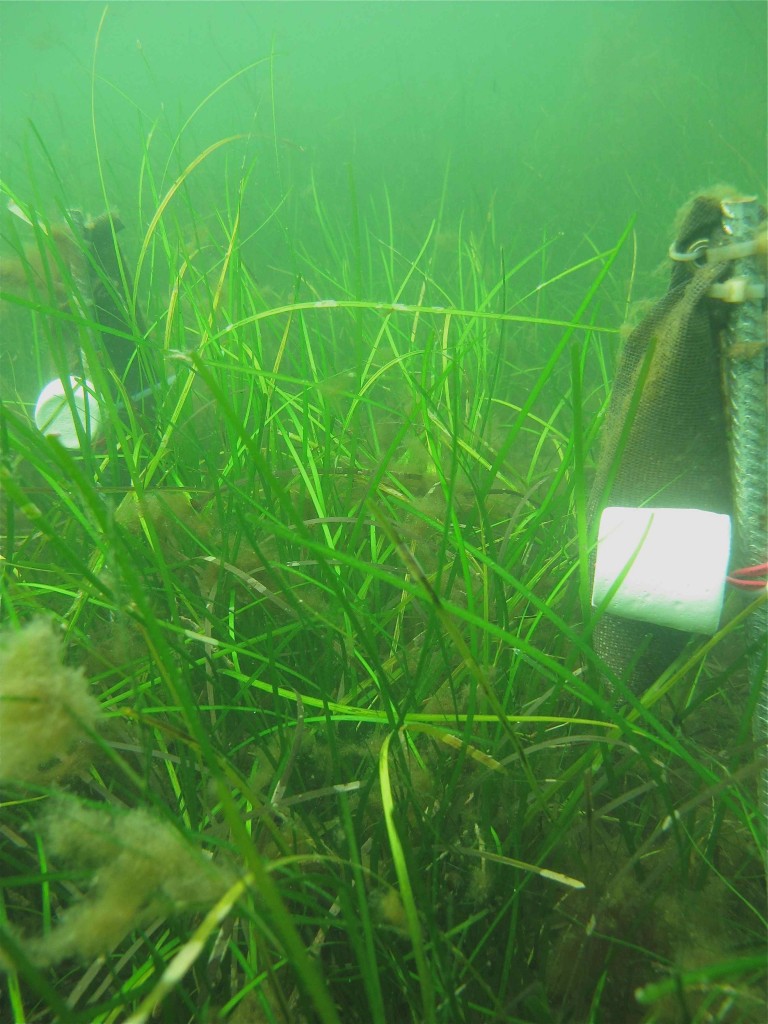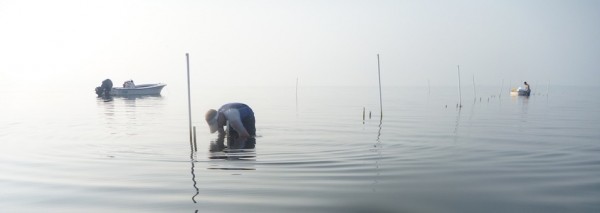New paper from ZEN: Biodiversity mediates top–down control in eelgrass ecosystems
* Press Release, 18 May 2015*
WORLDWIDE EXPERIMENT SHOWS THAT SMALL ANIMAL DIVERSITY MAINTAINS HEALTHY SEAGRASS MEADOWS
(Gloucester Point, VA) — Loss of small animals has surprisingly big effects on the health of valuable seagrass ecosystems, according to new results from a coordinated experiment spanning the northern hemisphere and led by biologists from the Virginia Institute of Marine Science (VIMS) and Smithsonian Institution.
The unprecedented experiment conducted simultaneously across 15 sites showed that algae-eating invertebrates control seaweeds that can smother seagrasses, and that more diverse animal communities perform this custodial service more effectively. Unexpectedly, biodiversity had stronger effects on productivity than did temperature or experimental fertilization.
Seagrass meadows provide valuable fish nurseries and protect coastlines, but are declining worldwide. “It’s widely understood that controlling algal overgrowth of seagrasses requires reducing fertilizer runoff, but it turns out that maintaining diverse populations of the bugs and slugs that clean these underwater plants is just as important. Our results provide rare large-scale confirmation of the importance of biodiversity to healthy ecosystems,” said Emmett Duffy, the study’s lead author and Director of the Smithsonian’s Tennenbaum Marine Observatories Network.
The worldwide experiment not only produced important confirmation of the importance of biodiversity, it also established a unique collaborative model for conducting large-scale ecological research, the Zostera Experimental Network (ZEN, www.zenscience.org), which involved scientists and students across seven countries. “Answering global challenges in ecology—from climate change to fisheries management—requires global approaches. The Zostera Experimental Network gives us an unprecedented opportunity to do that in coastal ecosystems”, said Pamela Reynolds, ZEN Program Coordinator and postdoctoral researcher at VIMS and the University of California, Davis.
ZEN’s research was greatly enhanced by leveraging the enthusiasm and contributions of students and international collaborators. “My students feel connected to a global research community, and are empowered to do research in this global context. ZEN has unquestionably revolutionized our approach to local-scale community ecology research,” said Mary O’Connor, co-author and Professor in the Department of Zoology at the University of British Columbia, Canada. The cooperation also produced a major payback on a modest investment, as emphasized by Per-Olav Moksnes of Gothenburg University, Sweden: “ZEN is a great example of what can be accomplished in science, despite limited resources, when a project is driven by enthusiasm of a global-scale collaborative field experiment, and in complete openness of sharing ideas and data.”
ZEN is now in its second generation and has expanded to 25 institutions and more than 50 research sites from the Russian Arctic to Mexico and South Korea. Ongoing work by this collaborative team seeks to understand how the diversity of seagrass animals and plants contributes to fish production, carbon storage and other ecosystem services. “ZEN exemplifies the synergisms of team science,” says co-author Jeanine Olsen, Professor at the Groningen Institute for Evolutionary Life Sciences in the Netherlands. “We’re embracing the diversity of our team of marine biologists,” Pamela Reynolds continues, “harnessing their expertise to do science that transcends borders, continents and disciplines. What happens in our own backyard is important, but by working together we strive to achieve better, more useful science for marine policy, management and conservation.”
The study was published in Ecology Letters and supported by grants from the National Science Foundation and local support from the 15 partner institutions.
###
For more information please contact:
Dr. J. Emmett Duffy
Director, Tennenbaum Marine Observatories Network, Smithsonian Institution
Glucksman Professor of Marine Science, Virginia Institute of Marine Science, The College of William and Mary
Dr. Pamela L. Reynolds
Program Coordinator, Zoster Experimental Network, Virginia Institute of Marine Science & University of California, Davis
###
Additional quotes from co-authors of the paper:
“This has been the most exciting research project of my career.” Emmett Duffy, Director, Tennenbaum Marine Observatories Network, Smithsonian Institution
“Seagrasses are declining worldwide due to a host of human-related factors. Our results show that small marine invertebrates are really important – they graze down seaweeds that might otherwise smother the seagrass. It’s a really neat partnership – the animals get a home and the seagrass stays clean. We found across the Northern Hemisphere that the more diverse communities of these little algae-eating animals do a better job of keeping the seagrass clean and healthy. Our results support that comprehensive management should consider how to maintain robust populations of animals in addition to managing for the more conspicuous effects of pollution and disturbance. We started with one NSF grant and 15 partner institutions in 2011. ZEN now includes 50 sites and over 200 scientists – from professors to graduate and undergraduate students, faculty and staff. It’s an unprecedented international collaboration among ecologists to experimentally test threats to coastal ecosystems. It’s a lot of work, but the results are powerful.” Pamela Reynolds, ZEN project coordinator and postdoctoral scholar at Virginia Institute of Marine Science and University of California, Davis
“In addition to clarifying the role of biodiversity for coastal ecosystem functioning, ZEN provides an excellent future platform for global comparisons of the role of seagrass meadows in provisioning other ecosystem services, such as CO2 sequestering and carbon storage.” Christoffer Boström, Associate Professor in Environmental and Marine Biology, Åbo Akademi University, FINALAND
“ZEN has really expanded the scale at which we understand our local eelgrass system. It has also created an integrated and collaborative research community who shares knowledge at every stage of the research process. My students feel connected to a global research community, and are empowered to do research in this global context. ZEN has unquestionably revolutionized our approach to local-scale community ecology research.” Mary O’Connor, Professor of Zoology at University of British Columbia in Vancouver, BC Canada
“I consider the ZEN project as a good example of scientific coordination and collaboration. The work revealed that results from combined dataset can be much more informative than when taken separately. It proofs the usefulness of a collaborative work to generate robust ecological results that can be applied to the hemisphere scale.” Mathieu Cusson, Professor of Fundamental Sciences at the Université du Québec à Chicoutimi in Quebec, Canada.
“The ZEN project provided the unique opportunity to perform research that takes local activity uniformly across an entire hemisphere, which makes it truly possible to distinguish general patterns/rules.” Aschwin Engelen, Researcher at University of Algarve, Portugal
“While particular issues such as the negative effects of nutrient pollution are important to consider in eelgrass conservation, our results show that strategies should consider the feedback loops that exist between the animals that inhabit eelgrass, and the plants themselves. For instance, healthy eelgrass habitat supports a high diversity of species, including those that support fisheries, but in turn the interactions among these animals have significant influence on the health of eelgrass. ” Kevin Hovel, Professor of Biology at San Diego State University.
“…the ZEN-project is a great example of what can be accomplished in science, despite limited resources, when a project is driven by enthusiasm of carrying out a global-scale collaborative field experiment, and in complete openness of sharing ideas and data.” Per-Olav Moksnes, Professor of Biological and Environmental sciences at Gothenburg University, Sweden
“Young scientists and grad students involved in ZEN have acquired wider perspectives… by observing eelgrass beds in different regions.” Masahiro Nakaoka, Professor at the Akkeshi Marine Station, Hokkaido University, Japan
“The ZEN project confirms the crucial importance of international cooperation to deliver results. ZEN exemplifies the synergisms of team science.” Jeanine Olsen, Professor at the Groningen Institute for Evolutionary Life Sciences, Groningen University, the Netherlands
“The striking thing about our findings is that even though the experiment was designed to test the role of other factors, it was variation among regions in the diversity of genes and species that consistently played a dominant role in the functioning of seagrass ecosystems. Honestly, its a new way of doing science for many of us… ceding control of our experiments and data collection is hard for many of us who were trained to be fiercely independent… but the payoff is this kind of surprising result that none of us could have obtained on our own and a built-in consensus because we were all involved in each phase of the project.” Jay Stachowicz, Professor of Evolution and Ecology, University of California, Davis
“Participating in ZEN expanded my professional network and my ecological worldview. As a master’s student I showcased my research and met my PhD advisor at our inaugural conference in Virginia. Later, ZEN’s graduate student exchange program sent me to two ZEN sites in Japan, where I forged lasting collaborations with Japanese scientists and explored the similarities and differences between eelgrass communities on opposite sides of the planet.” Matt Whalen, graduate student in Ecology at University of California, Davis and former master’s student at the Virginia Institute of Marine Science
“The ZEN experience broadened my view in science and showed me how valuable collaboration can be when you share a common passion and a common goal. Openness, exchange of ideas and fun — this is what ZEN meant to me.” Serena Donadi, postdoctoral researcher in the Department of Ecology, Environment and Plant Sciences at Stockholm University, Sweden
Welcome to ZEN
ZEN is a collaborative partnership among ecologists throughout the northern hemisphere conducting coordinated research in beds of eelgrass (Zostera marina) to tackle big questions about how biodiversity, climate change, and natural variability across the globe influence ecosystem structure and functioning. ZEN’s primary funding comes from the National Science Foundation, but benefits from in-kind support from partner institutions throughout the world. Continue Reading
ZEN at the 2012 Benthic Ecology Meeting
The Zostera Experimental Network (ZEN) team formally emerged into public view for the first time at the Benthic Ecology Meeting this past week in Norfolk, Virginia. ZEN coordinator Dr. Pamela Reynolds (top center in the photo, in red) presented a first look at the results of our 2011 experiment evaluating the relative importance of grazing, nutrient loading, and abiotic forcing on dynamics of eelgrass (Zostera marina) communities across the Northern Hemisphere.
ZEN had representation from several of our 15 global sites, and a diverse group of PIs, grad students and undergrads, at BEM this year. These included teams from northern Japan (PI Massa Nakaoka and grad student Kyosuke Momota), Quebec (graduate students Julie Lemieux and Laetitia Joseph), Massachusetts (PI James Douglass), North Carolina (PI Erik Sotka, grad students Rachel Gittman and Nicole Kollars, technicians Danielle Abbey and Alyssa Popowich), and Virginia (Emmett Duffy, Pamela Reynolds, Paul Richardson).
The abstract of Pamela’s presentation:
A comparative-experimental approach reveals complex forcing among bottom-up and top-down processes in seagrass communities across the Northern Hemisphere
Pamela L. Reynolds (1); Emmett Duffy (1); Christoffer Boström (2); James Coyer (3); Mathieu Cusson (4); James Douglass (5); Johan Eklöf (6); Aschwin Engelen (7); Klemens Eriksson (3); Stein Fredriksen (8); Lars Gamfeldt (6); Masakazu Hori (9); Kevin Hovel (10); Katrin Iken (11); Per-Olav Moksnes (6); Masahiro Nakaoka (12); Mary O’Connor (13); Jeanine Olsen (3); Paul Richardson (1); Jennifer Ruesink (14); Erik Sotka (15); Jay Stachowicz (16); Jonas Thormar (8)
(1) Virginia Institute of Marine Science, (2) Åbo Akademi University, (3) University of Gronigen, (4) Université du Québec à Chicoutimi, (5) Northeastern University, (6) University of Gothenburg, (7) Universidade do Algarve, (8) University of Oslo, (9) Fisheries Research Agency, Japan, (10) San Diego State University, (11) University of Alaska Fairbanks, (12) Hokkaido University, (13) University of British Columbia, (14) University of Washington, (15) College of Charleston, (16) University of California Davis
Two fundamental challenges to prediction in ecology are complexity and idiosyncrasy. How do we evaluate the importance and generality of multiple, interacting factors in mediating ecological structure and processes? One promising way forward is the comparative-experimental approach, integrating standardized experiments with observational data. In summer 2011 the Zostera Experimental Network (ZEN), a collaboration among ecologists across 15 Northern Hemisphere sites, initiated parallel field experiments exploring bottom-up and top-down control in eelgrass (Zostera marina) communities. Eelgrass is among the most widespread marine plants, forming ecologically and economically important but threatened coastal habitats. We factorially added nutrients and excluded small crustaceans (mesograzers) using a degradable chemical deterrent for four weeks, and measured responses of associated plant and animal communities. As expected, results varied strongly across the global range. Our cage-free deterrent strongly reduced crustacean grazers; at several sites grazer exclusion released blooms of epiphytic algae and/or sessile invertebrates. In Chesapeake Bay, these blooms reduced eelgrass biomass after eight weeks, demonstrating mutualistic dependence between eelgrass and mesograzers. Surprisingly, nutrient addition had little effect on epiphytes, except in Massachusetts and Sweden where grazers are suppressed by mesopredators. Ongoing research is analyzing the relative influence of grazer diversity and environmental forcing in mediating these processes.
Analysis of the 2011 experiments is still under way–even as we swing into high gear for planning the 2012 experiment. We will be presenting the complete results of the 2011 experiment at the Ecological Society of America meeting in Portland (August 2012) and the 47th European Marine Biology Symposium in Arendal, Norway (September 2012). We hope to see you at one or another of these events!
The dawn of ZEN
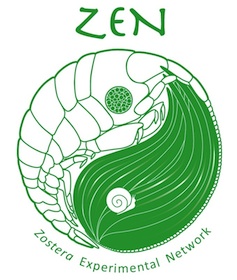 By Emmett Duffy, VIMS, ZEN Master
By Emmett Duffy, VIMS, ZEN Master
May I have the drum roll please . . .
Welcome, Ladies and Gentlemen, to the new official online home of the Zostera Experimental Network, known informally as ZEN. We are a global network of marine ecologists and evolutionary biologists from 15 sites (so far!) around the world, united in a quest to figure out how ecosystems associated with eelgrass (Zostera marina) work. The project has been seeded with generous support from the US National Science Foundation.
Eelgrass is one of the most widespread and important plants of the world’s shallow coastal seas and estuaries, ranging from above the Arctic circle to the balmy climes of Portugal, North Carolina, southern California, and southern Japan. ZEN has partner sites in all of those places. Extensive meadows of eelgrass support rich and productive biological communities of fish and shellfish, and provide important living buffers against storm and hurricane damage. As you might imagine, environmental pressures differ profoundly acros its broad range, from the glacial landscapes of northern Norway to the sweltering heat of the American southeast, as do the types of animals that live among the eelgrass. For these reasons, eelgrass beds are ideal candidates for exploring how gradients in environment and biodiversity influence the complex functioning of ecosystems.
ZEN is coordinated by myself and Dr. Pamela Reynolds at the Virginia Institute of Marine Science. We started officially in December of 2010 with a kick-off meeting that brought partners to Williamsburg, Virginia to plan strategy and finalize methods for our first big field experiment conducted in summer 2011.
On top of our day jobs, Pamela and I have been busy lately sorting the big trove of images from ZEN’s first global experiment in summer 2011, and wrestling with HTML code and other such arcana, in an effort to get the ZEN website up and running. There are still a few bugs to work out but we’re now pulling back the curtain, so voila! We hope you’ll find the site useful. For example you can find:
1) A list of ZEN’s participating partners and a little about the sites where they are working here. Stay tuned to the ZEN blog for updates on activities throughout the network.
2) A summary of the 2011 field experiment here — and first-hand accounts of the experiences of some of the students and others that participated here.
3) News of ZEN activities, publications, and research findings here.
And of course you can always leave a comment or send us an email using the little box at bottom of the page. Thanks for visiting. Y’all come back!
Undergraduate Education
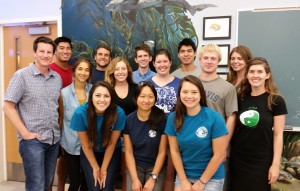 A novel component of the second generation of ZEN includes a formal integration of undergraduate education and involvement in the ZEN program. In spring 2014, we launched a coordinated upper division undergraduate Seagrass Ecosystem Ecology course at each of the three core ZEN sites: College of William & Mary, San Diego State University, and the University of California, Davis. The course focused on ecological theory and hands on training in marine ecology.
A novel component of the second generation of ZEN includes a formal integration of undergraduate education and involvement in the ZEN program. In spring 2014, we launched a coordinated upper division undergraduate Seagrass Ecosystem Ecology course at each of the three core ZEN sites: College of William & Mary, San Diego State University, and the University of California, Davis. The course focused on ecological theory and hands on training in marine ecology.
Research Network
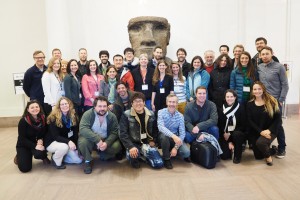 ZEN includes partners from seven US states and sixteen countries — Japan, South Korea, Canada, USA, Mexico, Norway, Sweden, Finland, Croatia, Ukraine, the Netherlands, Russia, France, Ireland, Wales, and Portugal. Partners include professors, postdoctoral researchers, graduate students, undergrads, and scientific staff. Our group’s expertise encompasses experimental ecology, population genetics, taxonomy, systematics, and quantitative analytical methods.
ZEN includes partners from seven US states and sixteen countries — Japan, South Korea, Canada, USA, Mexico, Norway, Sweden, Finland, Croatia, Ukraine, the Netherlands, Russia, France, Ireland, Wales, and Portugal. Partners include professors, postdoctoral researchers, graduate students, undergrads, and scientific staff. Our group’s expertise encompasses experimental ecology, population genetics, taxonomy, systematics, and quantitative analytical methods.
New paper in Ecology Letters!
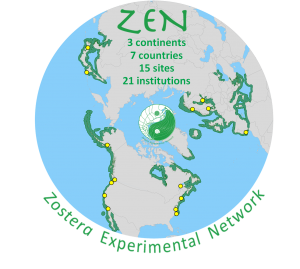 ZEN The first paper from our cross-cite experiment program is now published online at Ecology Letters! Our results link global and local evidence that biodiversity and top–down control strongly influence functioning of threatened seagrass ecosystems, and suggest that biodiversity is comparably important to global change stressors. See the press release and photos on our blog.
ZEN The first paper from our cross-cite experiment program is now published online at Ecology Letters! Our results link global and local evidence that biodiversity and top–down control strongly influence functioning of threatened seagrass ecosystems, and suggest that biodiversity is comparably important to global change stressors. See the press release and photos on our blog.
Why Seagrass?
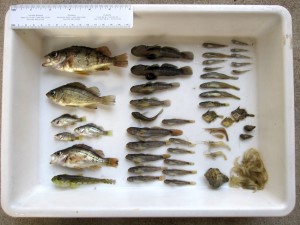 Seagrass beds are highly productive habitats, and provide structure and food for dense and diverse communities of animals. Seagrasses stabilize sediment, buffer coastlines, and improve water clarity, nutrient cycling and production. In many areas of the world eelgrass and other seagrasses serve as nursery habitats for juvenile fishes and shellfish, thus providing essential habitat for fisheries.
Seagrass beds are highly productive habitats, and provide structure and food for dense and diverse communities of animals. Seagrasses stabilize sediment, buffer coastlines, and improve water clarity, nutrient cycling and production. In many areas of the world eelgrass and other seagrasses serve as nursery habitats for juvenile fishes and shellfish, thus providing essential habitat for fisheries.
ZEN Blog
Virginia (slider image)
The Virginia site is located in the Goodwin Islands National Estuarine Research Reserve, at the mouth of the York River in Chesapeake Bay (37 o 13’ N, 76o 23’ W). Situated in the USA’s largest estuary, Goodwin Islands is a 3.15 km2 hectare archipelago of salt-marsh islands surrounded by a diverse array of habitats including seagrass beds, oyster reefs, tidal wetlands, mudflats and sandy shoals. Primary habitats at this site include intertidal flats and subtidal seagrass beds (Zostera marina and Ruppia maritima). The surrounding salt marsh vegetation is dominated by cordgrass (Spartina alterniflora) and salt meadow hay (Spartina patens). Although this area is closed to development and destructive use, it remains open to commercial and recreational fishing.

